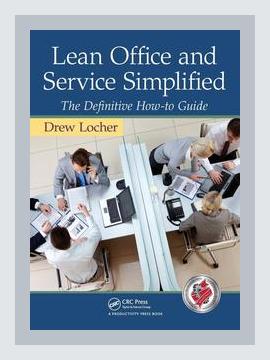Operations and Supply Chain ManagementProcess Improvement
Lean Office and Service Simplified: The Definitive How-To Guide by Drew Locher – A Summary
Introduction
“Lean Office and Service Simplified: The Definitive How-To Guide” by Drew Locher is a comprehensive manual designed to apply lean principles traditionally associated with manufacturing to office and service environments. The book addresses the unique challenges these sectors face and provides pragmatic strategies to enhance efficiency and value delivery.
Chapter 1: Understanding Wastes in Office and Service Environments
Key Point: Identifying Types of Waste
As in manufacturing, waste in service and office settings can also impede efficiency. Locher emphasizes seven types of waste:
- Overproduction – Generating reports or data not immediately needed.
- Waiting – Idle time as employees wait for information or approvals.
- Transport – Inefficient movement of documents or materials.
- Extra Processing – Unnecessary steps in processes.
- Inventory – Excess of data, files, or unused supplies.
- Motion – Unnecessary movements by employees.
- Defects – Errors in information or services necessitating rework.
Action: Create a waste audit checklist to frequently evaluate processes and identify waste areas, encouraging staff to recognize and report waste.
Chapter 2: Value Stream Mapping (VSM)
Key Point: Visualizing Processes
Value Stream Mapping involves documenting the flow of materials and information through processes to identify bottlenecks and areas of improvement.
Example: A law firm could map the process of client onboarding, from initial contact through document preparation and case assignment, to streamline steps and reduce lead times.
Action: Conduct VSM workshops with cross-functional teams to draw current state maps of key processes and brainstorm improvements to develop future state maps.
Chapter 3: Implementing 5S for Organization
Key Point: The 5S Methodology
5S (Sort, Set in order, Shine, Standardize, Sustain) is critical for maintaining an organized and efficient work environment.
- Sort: Eliminate unnecessary items.
- Set in Order: Arrange items for accessibility.
- Shine: Clean and inspect areas for maintenance.
- Standardize: Develop procedures to maintain organization.
- Sustain: Cultivate discipline to continue practices.
Example: A healthcare clinic might sort and label medical supplies, arrange them for easy access, regularly clean inventory areas, standardize storage practices, and audit to ensure continued compliance.
Action: Launch a 5S initiative by selecting a pilot area, involving employees in sorting and organizing, and setting tangible goals for each 5S component.
Chapter 4: Creating Flow and Pull Systems
Key Point: Enhancing Process Flow
Creating continuous flow and implementing pull systems prevent bottlenecks and overproduction.
Example: In a financial services office, a pull system could mean that reports are prepared only when requested by clients, rather than predicting future needs.
Action: Examine processes for potential flow interruptions. Design work cells where related tasks are co-located and initiate pull systems by defining clear triggers for task initiation.
Chapter 5: Standard Work and Visual Management
Key Point: Establishing Standard Work
Standard work facilitates consistency, efficiency, and quality in service delivery.
Example: A customer service department could develop standard scripts and response templates to ensure uniformity in how clients are handled.
Action: Work with employees to document best practices for key tasks, creating standard operating procedures (SOPs) and visual aids like process charts to reinforce adherence.
Chapter 6: Reducing Lead Time and Batch Sizes
Key Point: Managing Lead Time
Reducing the lead time between the commencement and completion of tasks is crucial. Smaller batch sizes can also significantly enhance responsiveness and reduce delays.
Example: An insurance company reducing the batch size of claims processed can drastically cut down the lead adjudication timeframe, leading to quicker customer responses.
Action: Re-evaluate work process batch sizes, aim to reduce them, and measure the lead time pre- and post-implementation to gauge improvements.
Chapter 7: Problem-Solving and Continuous Improvement
Key Point: Cultivating Continuous Improvement
Implementing continuous improvement routines like Kaizen events to regularly address and resolve inefficiencies.
Example: A library might hold monthly problem-solving sessions to streamline book check-in/check-out processes or improve cataloging accuracy.
Action: Set up a continuous improvement team tasked with identifying issues and leading bi-weekly problem-solving sessions, ensuring every team member contributes.
Chapter 8: Lean Metrics and Performance Management
Key Point: Measuring Success
Lean metrics provide a quantitative basis for assessing process performance and effectiveness.
Example: An IT helpdesk can use metrics like average resolution time, first-call resolution rate, and customer satisfaction scores to track and improve performance.
Action: Develop a balanced scorecard of lean metrics relevant to your processes, and routinely review these metrics in team meetings to identify areas for improvement.
Chapter 9: Leadership and Cultural Change
Key Point: Role of Leadership
Effective leadership and a supportive organizational culture are essential for successful lean transformations.
Example: A retail company ensures that managers are trained in lean methodologies and encourage a culture of continuous improvement through regular coaching and support.
Action: Provide lean training for all leadership levels, and establish a reward system recognizing employees who contribute significantly to process improvements.
Chapter 10: Lean Implementation Strategies
Key Point: Practical Implementation
Locher provides a roadmap for initiating lean transformations through strategic planning and phased implementation.
Example: A municipal government department can implement lean practices in stages, beginning with high-impact areas like permit processing before expanding to other services.
Action: Develop a strategic lean implementation plan with clear timelines, phased rollout of lean practices, and defined metrics for each phase’s success evaluation.
Conclusion
“Lean Office and Service Simplified: The Definitive How-To Guide” by Drew Locher is an invaluable resource for anyone seeking to bring lean principles to office and service settings. Through actionable strategies and real-world examples, the book illustrates how organizations can reduce waste, enhance workflow, and continuously improve processes to deliver superior value. Emphasizing teamwork, leadership, and a culture of continuous improvement, this guide serves as a definitive path for streamlining and optimizing service operations.
This structured summary provides a detailed overview of Locher’s main points along with specific actions for implementation, reflecting the practical and goal-oriented nature of the book.
